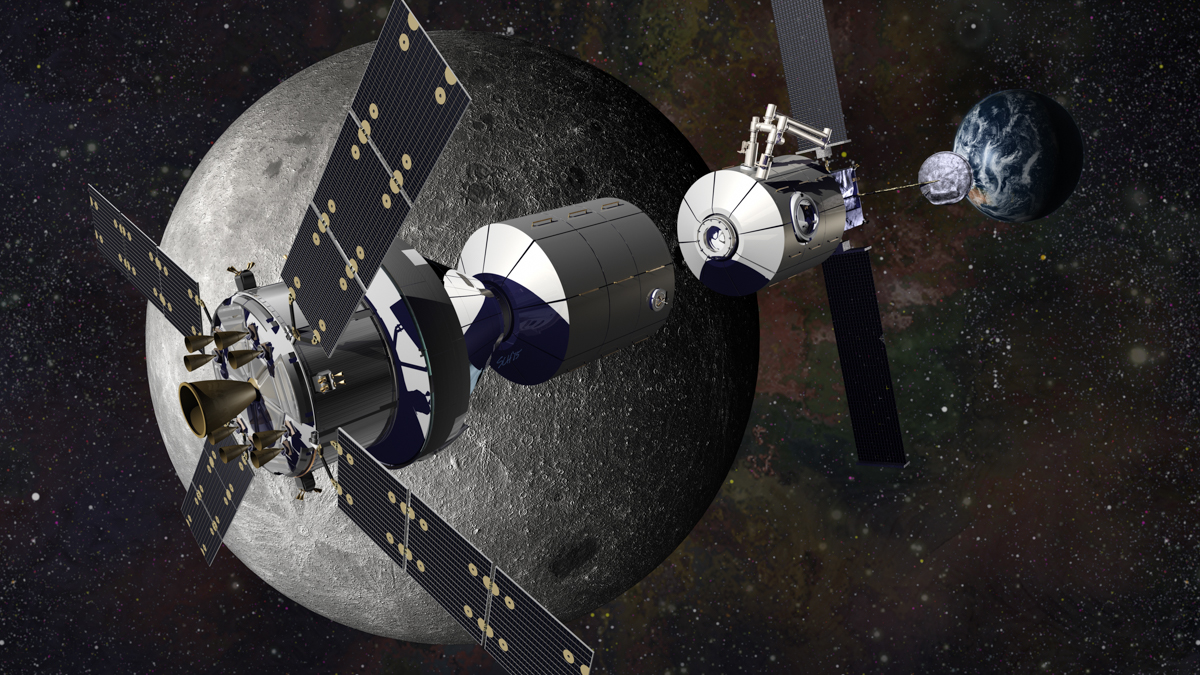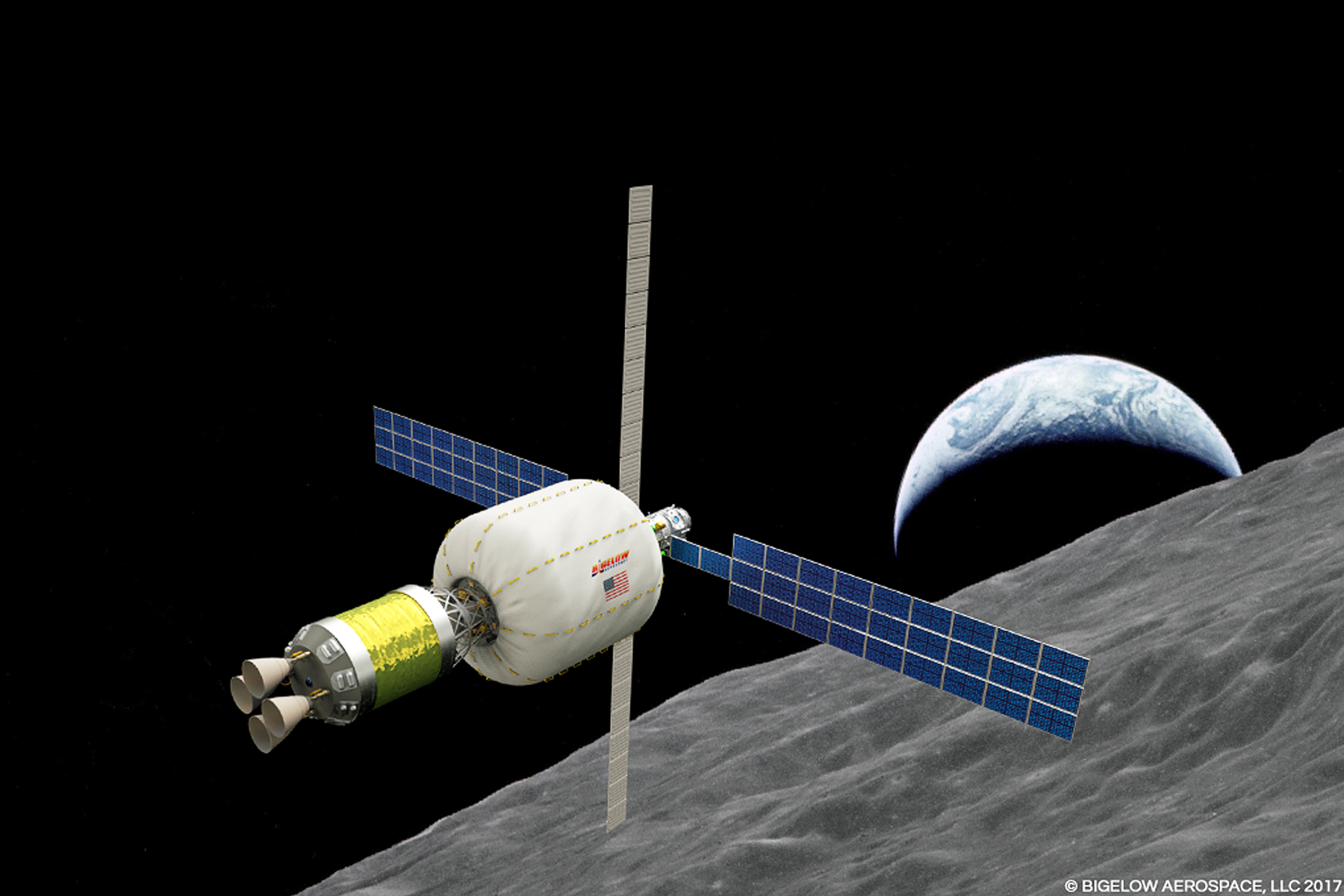"Roscosmos" entrusted the construction of a lock module at the International lunar orbital station

The artistic image of the future orbital base Deep Space Gateway. Illustration: Lockheed-Martin
As stipulated by the agreement between Roscosmos and NASA on joint deep-space research , the Russian corporation will take part in the construction of the International Moon Orbital Station Deep Space Gateway in the near-moon space. According to the preliminary plan, this base will become a platform for studying the surface of the Moon, delivering valuable asteroids and conducting various missions in deep space, including missions to Mars.
An important part is entrusted to Roscosmos in the international project - the construction of a small lock module weighing 4.6 tons. The module of two compartments will be created under the American standards for the voltage in the electrical network and system interfaces. They will also be managed through the American systems.
An anonymous source in the rocket and space industry told the newspaper Izvestia that Roskosmos and NASA agreed on a schedule for the participation of Russian specialists in an international project. According to the plan, the launch of the Russian lock module is scheduled for 2026. This module will be the last item in the station configuration. At least in the configuration that is defined today, without taking into account potential expansion in the future.
So far, a specific plan for Russian participation has been agreed at the level of working groups. The document should be approved in November at a meeting of the heads of space agencies - partners of the ISS, so there is no official announcement from Roscosmos.
“We have been allocated the creation of a small module from two compartments to perform work in open space. The Russian modules of the International Space Station, Pierce and Uzlovoy, are considered as prototypes for it, ”the source said.
The docking compartment-module Pirs (CO1) is one of the modules of the Russian segment of the ISS. It is intended for use as an additional port for mooring manned and cargo ships of the Soyuz and Progress type and ensuring the exit of cosmonauts and astronauts into open space from the Russian segment of the station. It was launched on September 15, 2001, began work in June 2002.

Docking bay-module "Pier"
As for the second mentioned module “Uzlovoy”, it is quite likely that the source here is referring to the universal node module “Berth” - one of the modules of the Russian segment of the ISS planned for launch in 2018, manufactured in 2014 by RSC Energia (now stored on site).

Model of the Nodal Module at the Yu. A. Gagarin Cosmonaut Training Center
Roscosmos planned that if the ISS was completed in 2024, the Nodal module, as well as two new Russian modules - a multifunctional laboratory module and a Scientific and energy module - would be undocked and would become the basis of the Russian national orbital station.
The airlock module is planned to be put into orbit with the help of the Angara-A5M launch vehicle (the upgraded version of the Angara-A5 with RD-191M engines), and if there are problems with the creation and testing of the Angara-A5M, then the American superheavy SLS launch vehicle.
Russia has so far been entrusted only with the construction of the airlock module, Roscosmos is counting on more: “Further participation is possible with many options, including our transport system — launch vehicles and space ships, the participation of our automatic vehicles of the Luna series in selecting landing sites man to the surface, ”said Sergey Krikalev, executive director of the Roscosmos state corporation.
After 10 years, the International Moon Orbital Station may not be the only human base in near-moon space. Thus, a private company Bigelow Aerospace announced a plan to deploy an inflatable module B330 in circum-orbit around 2022 . Another module Bigelow Aerospace is now docked to the ISS, where it proved its viability.

An example of an orbital station from two B330 modules and two docked Dragon 2 capsules. Render: Bigelow Aerospace
To bring the module into orbit, an agreement has been concluded with the private company United Launch Alliance (ULA), which will provide the Vulcan 562 launch vehicle for this purpose. In addition to the module itself, Vulcan will perform two more launches, with each of which will launch the first stage of the ACES rockets into orbit. (Advanced Cryogenic Evolved Stage) and 35 tons of cryogenic fuel. There, the fuel will be merged into one stage, which will deliver the B330 module to circumlunar orbit.
However, it is not planned to make a habitable base out of the B330 modules. The company Bigelow Aerospace expects to use the B330 as a cargo warehouse - a kind of space warehouse.

Module B330 against the surface of the moon. Render: Bigelow Aerospace
All Articles